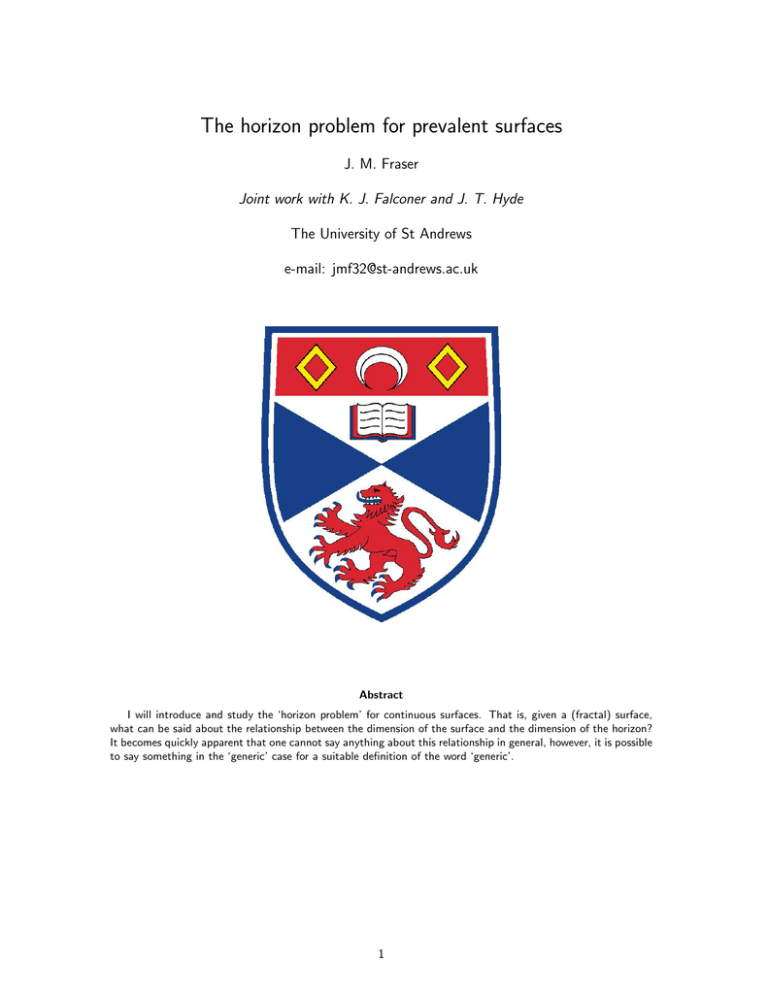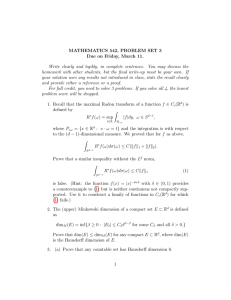The horizon problem for prevalent surfaces
advertisement

The horizon problem for prevalent surfaces
J. M. Fraser
Joint work with K. J. Falconer and J. T. Hyde
The University of St Andrews
e-mail: jmf32@st-andrews.ac.uk
Abstract
I will introduce and study the ‘horizon problem’ for continuous surfaces. That is, given a (fractal) surface,
what can be said about the relationship between the dimension of the surface and the dimension of the horizon?
It becomes quickly apparent that one cannot say anything about this relationship in general, however, it is possible
to say something in the ‘generic’ case for a suitable definition of the word ‘generic’.
1
The horizon problem for prevalent surfaces
C[0, 1]d = {f : [0, 1]d → R f is continuous}
A fractal surface
The horizon function, H(f ) ∈ C[0, 1], of f ∈ C[0, 1]2 is defined by
H(f )(x) = sup f (x, y)
y∈[0,1]
We will say that f ∈ C[0, 1]2 satisfies the horizon property (for box
dimension) if
dimB GH(f ) = dimB Gf − 1
2
Prevalence.
Let X be a completely metrizable topological vector space. A set F ⊆ X
is prevalent if the following conditions are satisfied:
1) F is a Borel set;
2) There exists a Borel measure µ on X and a compact set K ⊆ X
such that 0 < µ(K) < ∞ and
µ X \ (F + x) = 0
for all x ∈ X.
The complement of a prevalent set is called a shy set.
Remark: (C[0, 1]2, d∞) is a completely metrizable topological vector
space.
Box dimensions.
Let F ⊂ Rd be bounded
dimBF = limδ→0
and
log Nδ (F )
− log δ
log Nδ (F )
− log δ
where Nδ (F ) is the number of cubes in a δ-mesh which intersect F .
dimBF = limδ→0
3
Theorem 1.1 (Falconer and F, ’11).
A prevalent function f ∈ (C[0, 1]2, d∞) satisfies:
dimB Gf = 3
and
dimB GH(f ) = 2.
Let α ∈ [2, 3) and let
o
n
2
Cα [0, 1] = f ∈ C[0, 1] : dimBGf 6 α
2
Proposition 1.2 (Falconer and F, ’11). Cα [0, 1]2 is a completely
metrizable topological vector space when equipped with a (natural) metric dα .
Remark: The topology generated by dα is strictly finer than that generated by d∞.
Theorem 1.3 (Falconer and F, ’11).
A prevalent function f ∈ (Cα [0, 1]2, dα ) satisfies:
dimB Gf = α
and
α − 1 6 dimBGH(f ) 6 dimBGH(f ) 6 2.
4
A (very short) note on the proof.
Proposition 1.4 (Falconer and F, ’11).
Let f, g ∈ C[0, 1]d. Then
max dimBGf , dimBGg
6 dimBGf +λg 6 dimBGf +λg
= max dimBGf , dimBGg
for L1-almost all λ ∈ R.
Proof. Lots of box-counting and the Borel-Cantelli Lemma.
Let α ∈ [2, 3], let ψ ∈ C[0, 1] satisfy
dimB Gψ = α − 1
and define Ψ ∈ C[0, 1]2 by
Ψ(x, y) = ψ(x).
Finally, let
K = λΨ : λ ∈ R ⊂ C[0, 1]2
and
µ = LK
5
Question: Can we obtain sharper results on the box dimension
of the horizon of a prevalent surface?
Let α ∈ [2, 3) and let
n
Uα [0, 1] = f ∈ Cα [0, 1]2 : dimB Gf = α
2
and
α − 1 6 dimBGH(f ) 6 dimBGH(f )
o
<2 .
and
n
Lα [0, 1] = f ∈ Cα [0, 1]2 : dimB Gf = α
2
and
α − 1 < dimBGH(f ) 6 dimBGH(f )
Theorem 1.5 (Falconer and F, ’11).
(1) Uα [0, 1]2 is not a prevalent subset of (Cα [0, 1]2, dα );
(2) Lα [0, 1]2 is not a prevalent subset of (Cα [0, 1]2, dα ).
6
o
62 .
Discussion and questions.
1) What about Hausdorff dimension and packing dimension?
We have recently obtained the following result:
Theorem 1.6 (F and Hyde, ’11).
A prevalent function f ∈ (C[0, 1]2, d∞) satisfies:
dimH Gf = dimP Gf = 3
and
dimH GH(f ) = dimP GH(f ) = 2.
2) How about surfaces with Hausdorff or packing dimension less than 3?
It can be shown that
n for α < 3 the set
o
2
f ∈ C[0, 1] : dimH Gf 6 α
is not a vector space because it is not closed under addition (see [MW])
and so we cannot conduct the same analysis as we did in the box dimension case.
3) Is it true that for all f, g ∈ C[0, 1]d we have
dimP Gf +g 6 max{dimP Gf , dimP Gg }?
7
References
[FF] K. J. Falconer and J. M. Fraser. The horizon problem for prevalent
surfaces, preprint (2011).
[FH] J. M. Fraser and J. T. Hyde. The Hausdorff dimension of graphs
of prevalent continuous functions, preprint (2011).
[MW] R. D. Mauldin and S. C. Williams. On the Hausdorff dimension of
some graphs, Trans. Amer. Math. Soc., 298, (1986), 793–803.
8





